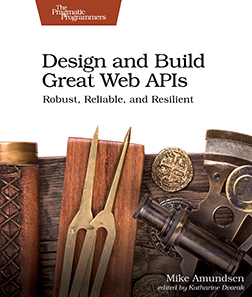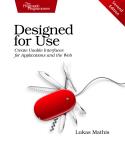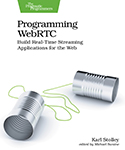About This Title
Pages: 330
Published: October 2020
ISBN: 9781680506808
In Print

Design and Build Great Web APIs
Robust, Reliable, and Resilient
by Mike Amundsen
APIs are transforming the business world at an increasing pace. Gain the essential skills needed to quickly design, build, and deploy quality web APIs that are robust, reliable, and resilient. Go from initial design through prototyping and implementation to deployment of mission-critical APIs for your organization. Test, secure, and deploy your API with confidence and avoid the “release into production” panic. Tackle just about any API challenge with more than a dozen open-source utilities and common programming patterns you can apply right away.
eBook Formats:
PDF for desktop/tablets
epub for Apple Books, e-readers
mobi for Kindle readers
Get all eBook formats here for $27.95 (USD)
Paperback Formats:
Order via Bookshop (U.S. Only)
Please support indie bookstores!
Find indie bookstores in the U.S. Find indie bookstores around the world.
Good API design means starting with the API-first principle—understanding who is using the API and what they want to do with it—and applying basic design skills to match customers’ needs while solving business-critical problems. Use the Sketch-Design-Build method to create reliable and scalable web APIs quickly and easily without a lot of risk to the day-to-day business operations. Create clear sequence diagrams, accurate specifications, and machine-readable API descriptions, all reviewed, tested, and ready to turn into fully-functional NodeJS code.
Create reliable test collections with Postman and implement proper identity and access control security with AuthO—without added cost or risk to the company. Deploy all of this to Heroku using a continuous delivery approach that pushes secure, well-tested code to your public servers, ready for use by both internal and external developers.
From design to code to test to deployment, unlock hidden business value and release stable and scalable web APIs that meet customer needs and solve important business problems in a consistent and reliable manner.
What You Need
All the examples in this book are created using JavaScript and NodeJS installed on your own local laptop or workstation running Windows, MacOS, or Linux. You’ll need accounts on Github and Heroku in order to build, check in, and deploy your code to a live server. You’ll also be using Postman for testing, Auth0 to secure your APIs, and a handful of open-source command-line utilities and your favorite text editor to complete the exercises in the book.Resources
Releases:
Contents & Extracts
- Getting Started
- Getting Started with API First
excerpt

- Adopting the API-First Principle
- Exploring APIs with curl
- What’s Next?
- Chapter Exercise
- Understanding HTTP, REST, and APIs
- Understanding Web API Protocols, Practices, and Styles
- Managing Files with Git
- What’s Next?
- Chapter Exercise
- Getting Started with API First
excerpt
- The Design Phase
- Modeling APIs
- Understanding Norman’s Action Lifecycle
- Modeling Our Onboarding API Lifecycle
- Managing Your Project with npm
- What’s Next?
- Chapter Exercise
- Designing APIs
excerpt

- The Power of Design
- The API Design Method
- Identifying Your API Descriptors
- Creating Your Sequence Diagram
- What’s Next?
- Chapter Exercise
- Describing APIs
- Learning the Role of Description Formats
- Describing Your API with ALPS
- Updating Your API Project
- What’s Next?
- Chapter Exercise
- Modeling APIs
- The Build Phase
- Sketching APIs
excerpt

- Learning from Frank Gehry’s Sketches
- API Sketching Example
- The Advantages of Sketching
- Sketching APIs with Apiary Blueprint
- API Sketching Tips and Tricks
- What’s Next?
- Chapter Exercise
- Prototyping APIs
- What Is an API Prototype?
- API Prototyping with OpenAPI
- Translating Your API Design into HTTP
- Creating Your OpenAPI Document with SwaggerHub
- Saving and Exporting Your API
- Mocking Your API
- Generating Your API Documentation
- What’s Next?
- Chapter Exercise
- Building APIs
- Defining the API Build Process
- Relying on a Repeatable Process
- Coding APIs with NodeJS and DARRT
- Putting It All Together
- What’s Next?
- Chapter Exercise
- Sketching APIs
excerpt
- The Release Phase
- Testing APIs
- The Goals of API Testing
- Testing with SRTs
- Using Postman for API Testing
- Running Tests Locally with Newman
- What’s Next?
- Chapter Exercise
- Securing APIs
- Understanding Security Basics
- Implementing API Security with Auth0
- Supporting Machine-to-Machine Security
- What’s Next
- Chapter Exercise
- Deploying APIs
- The Basics of Deployment Pipelines
- The Role of DevOps
- Deploying with Heroku
- What’s Next?
- Chapter Exercise
- Modifying APIs
- Going Beyond Versioning
- The Three Rules for Safely Modifying APIs
- The Recommended Pattern for Testing for API Changes
- The Process for Safely Deploying APIs
- Shutting Down an Existing API
- What’s Next?
- Some Parting Thoughts
- Getting Started
- The Design Phase
- The Build Phase
- The Release Phase
- What’s Next?
- Testing APIs
- Appendixes
- Installation Hints
- curl
- Git
- GitHub and SSH
- NodeJS and npm
- Postman
- Newman
- Heroku Client
- Installing the Local Utiltities
- Exercise Solutions
- Where’s the Code?
- Solution for Chapter 1: Getting Started with API First
- Solution for Chapter 2: Understanding HTTP, REST, and APIs
- Solution for Chapter 3: Modeling APIs
- Solution for Chapter 4: Designing APIs
- Solution for Chapter 5: Describing APIs
- Solution for Chapter 6: Sketching APIs
- Solution for Chapter 7: Prototyping APIs
- Solution for Chapter 8: Building APIs
- Solution for Chapter 9: Testing APIs
- Solution for Chapter 10: Securing APIs
- Solution for Chapter 11: Deploying APIs
- API Project Assets Checklist
- Using the API Project Assets Checklist
- Notes on the Assets Checklist
- Your API Project Assets Checklist
- Installation Hints
Author
An internationally known author and speaker, Mike Amundsen travels the world consulting and talking about network architecture, web development, and the intersection of technology and society. He works with companies large and small to help them capitalize on the opportunities APIs and microservices present for both consumers and the enterprise.eBook Formats:
PDF for desktop/tablets
epub for Apple Books, e-readers
mobi for Kindle readers
Get all eBook formats here for $27.95 (USD)
Paperback Formats:
Order via Bookshop (U.S. Only)
Please support indie bookstores!
Find indie bookstores in the U.S. Find indie bookstores around the world.
Related Titles:

About This Title
Pages: 330
Published: October 2020
ISBN: 9781680506808
Edition: 1
In Print






